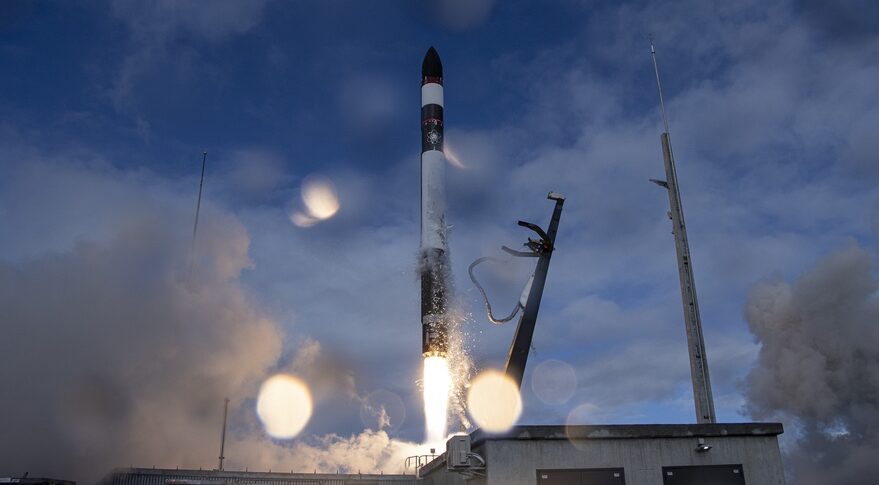WASHINGTON — Rocket Lab, the company best known for its Electron small launch vehicle, generated most of its first quarter revenue from other space systems and not launch itself.
In quarterly earnings released May 16, Rocket Lab reported $40.7 million in revenue for the first quarter of 2022, a net loss of $26.7 million and an adjusted earnings before interest, taxes, depreciation and amortization (EBITDA) loss of $8 million.
The earnings revealed a striking difference between the company’s two main lines of business, launch and space systems. That latter category, which includes its Photon spacecraft and components business, generated $34.1 million in revenue in the quarter. Launch provided only $6.6 million from a single Electron launch.
That split reflects an aggressive diversification strategy that accelerated after the company went public in August 2021 through a special-purpose acquisition corporation (SPAC) merger. Since the merger closed, Rocket Lab acquired flight software company Advanced Solutions Inc., satellite separation system manufacturer Planetary Systems Corporation and solar panel manufacturer SolAero Holdings. The SolAero deal closed in the first quarter.
The closing of the SolAero acquisition was a major factor in the sharp increase in the company’s backlog, from $241 million at the end of the fourth quarter of 2021 to $546 million at the end of the first quarter. The other major contributor was a $143 million contract the company won from Canadian company MDA in February to produce 17 spacecraft for Globalstar.
The company projects that revenue difference to continue in the second quarter, although not nearly as pronounced. The company forecasts $51 million to $54 million in revenue in the second quarter, with space systems generating $32 million to $35 million and launch $19 million.
The launch revenue comes from three Electron launches scheduled for the second quarter, two of which have already taken place. The third is the Electron launch of NASA’s CAPSTONE lunar smallsat mission, scheduled for the end of May. Adam Spice, Rocket Lab’s chief financial officer, said on the company’s earnings call there is a possibility of a fourth launch in the quarter, a mission for an unidentified government customer in late June. The company is not including that launch in its revenue forecast for the quarter.
Rocket Lab recognizes launch revenue in the quarter the launch takes place, which can result in significant variations from quarter to quarter depending on when launches take place. The first launch of the second quarter, carrying two BlackSky imaging satellites, took place in early April but was postponed from late March because of weather, causing the quarter in which the revenue was recognized to shift from the first to the second quarter.
Launch cadence is “dominated by customer readiness,” said Peter Beck, Rocket Lab chief executive, on the call. “Launch is always a little bit lumpy.”
There is also a variation in revenue per launch, company executives acknowledged. The CAPSTONE launch is valued at about $10 million under the contract NASA awarded in 2020. However, Spice said that the company’s previous launch May 2, carrying 34 smallsats, produced only a “de minimis” amount of revenue.
“That was primarily an R&D platform. It had relatively small revenue contribution,” he said. “It wasn’t a regular launch at all.”
Catch catchup
Rocket Lab treated that launch differently because it was the company’s first attempt to catch the rocket’s first stage in midair during its descent using a helicopter, part of its strategy to reuse the boosters. The helicopter did catch the booster, but released it seconds later when the pilot was concerned that the load of the booster on the helicopter was different from that experienced in tests.
“Quite frankly, I would have been pretty happy if we had only just sighted the stage coming back from the helicopter, but to actually catch it on the first go was a tremendous feat,” Beck said on the call.
With the catch and release, he said the company is about 90% to its ultimate goal of catching a booster in midair, returning it to land and reusing it. The booster on this launch was recovered from the water shortly after splashdown and engineers are inspecting it to see what components could potentially be reused.
The booster was in “extraordinarily good” condition, he said. “If we held that in the hook and brought it home, we’d be seriously thinking about putting that thing back on the pad.”
Beck didn’t give a schedule for attempting another midair booster recovery, saying the company wanted to first do more practices with the helicopter. The company won’t attempt recovery of the booster on the upcoming CAPSTONE launch. “We’ll make a few tweaks and get back out there in the not-too-distant future for another attempt.”
In the long term, Beck estimated that the company will attempt recovery on about half of all Electron launches. The recovery systems reduce the vehicle’s payload by 10% to 15%, he said, and some customers need all of Electron’s performance for their missions. Spice said the company would likely use a booster first on missions with lower performance requirements that enable reusability, then at the end of its life launch on a mission whose higher performance needs would rule out recovery.

